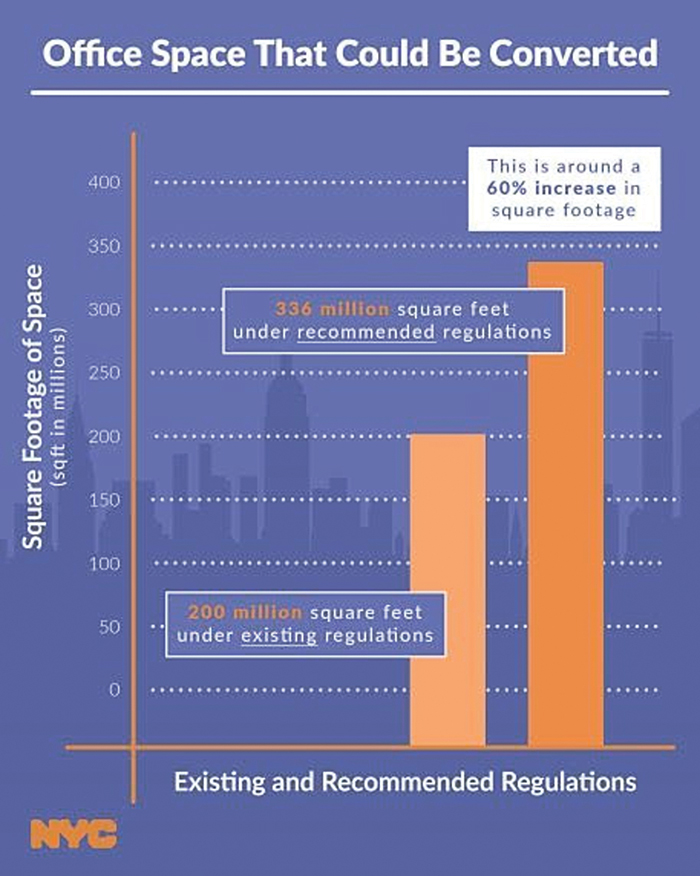Courtesy of NYC Mayor’s Office
Implementing the task force’s recommendations would extend the most flexible conversion regulations to an additional 136 million square feet of office space — roughly the amount of office space in the entire city of Philadelphia.
By Forum Staff
Mayor Eric Adams on Monday unveiled recommendations from a city-led task force to facilitate the conversion of underused office space into new housing for New Yorkers. Crafted by the Office Adaptive Reuse Task Force, and led by New York City Department of City Planning (DCP) Director Dan Garodnick, the New York City Office Adaptive Reuse Study presents 11 concrete recommendations that would make changes to state laws and city zoning requirements in an effort to extend the most flexible conversion regulations to an additional 136 million square feet of office space — roughly the amount of office space in the entire city of Philadelphia. While property owners will make determinations whether to convert their buildings, with these recommendations in place and current city and state regulations, office conversions could potentially create as many as 20,000 homes in the next decade, enough to house up to 40,000 New Yorkers.
The study outlines a path forward to deliver on goals outlined in “‘New’ New York: Making New York Work for Everyone,” an action plan released in December by Mayor Adams and Gov. Kathy Hochul — including reimagining the city’s commercial districts as vibrant 24/7 destinations, making Midtown Manhattan and other business districts more mixed-use and flexible, and expanding the city’s supply of housing. It also builds on Mayor Adams’ “Get Stuff Built,” “City of Yes,” and “Housing Our Neighbors” plans, which include significant steps to tackle the city’s severe housing shortage. Increasing opportunities to repurpose underused office space for housing and other uses is critical to achieving those goals.
The Office Adaptive Reuse Task Force was convened by the Adams administration in July 2022 following Local Law 43, sponsored by New York City Councilman Justin Brannan (D-Brooklyn).
The task force’s recommendations include:
- Expanding the universe of office buildings with the most flexible regulations for conversion to residential use from buildings constructed through 1961 to those constructed through 1990 — easing the potential conversion process for an additional 120 million square feet of office space;
- Expanding flexible conversion regulations to all high-intensity office districts, including Downtown Flushing and the Bronx Hub — easing the potential conversion process for an additional 16 million square feet of office space;
- Finding opportunities to allow housing, whether through conversions or new construction, in a centrally located, high-density part of Midtown that currently prohibits residential development;
- Allowing office buildings to convert to various much-needed types of housing, including supportive housing;
- Providing flexibility for offices to convert all existing space into housing, eliminating limitations that incentivize only partial conversions or make conversion projects infeasible;
- Exploring and pursuing a tax incentive program to support the production of affordable and mixed-income housing through office conversions — adding to the city’s affordable housing stock without deterring other private investment in conversions and housing creation; and
- Creating a property tax abatement program to incentivize retrofitting office space for child care centers, building on Mayor Adams’ “Accessible, Equitable, High-Quality, Affordable: A Blueprint for Child Care & Early Childhood Education in New York City.”
These recommended reforms would be implemented via changes to state law and regulatory changes through a City zoning text amendment, Adams noted.

